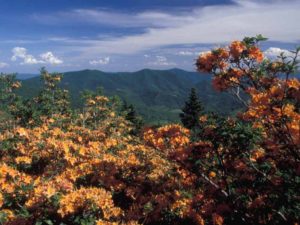There are seventeen species of native deciduous azaleas in North America. One is native to the West Coast while the others are native to the East Coast of the United States and Canada.
They are typically classified according to flower color. click for details and photos of each species.
Much of the material shown below was assembled by Don Hyatt, George McLellan, and Dr. Sandra McDonald and presented at a 2000 ARS Convention lecture and subsequently published in the Journal of the American Rhododendron Society.
Many of these species may coexist in nature. Over time, there has been a good deal of natural hybridization—making taxonomy difficult at best. Charles Andrews, VP of the the Azalea Society, presented an excellent overview of natural hybrids in 2018. Attached is a copy of that presentation in PDF format (9Mb).

R. calendulaceum - Engine Gap, NC
The "White Group"
The “White Group” includes seven species, six of which have been found growing in the Eastern United States and Canada, and one, R. occidentale, found growing wild on the West Coast. The six Eastern species are: R. alabamense, R. arborescens, R. atlanticum, R. viscosum, a recently identified species from South Carolina, R. eastmanii, and a second new species from Alabama, R. colemanii.
The "Pink Group"
The “Pink Group” all bloom in early spring, usually before the leaves have fully expanded. Flowers range from pale pink, to deep rose, to almost cherry red. There are five species in this group: R. canadense, R. canescens, R. periclymenoides, R. prinophyllum, and R. vaseyi.
The "Orange to Red Group"
The “Orange to Red Group” includes five species whose flowers can range from yellow, through gold, to deep orange or scarlet: R. austrinum, R. calendulaceum, R. cumberlandense, R. flammeum, and R. prunifolium.
